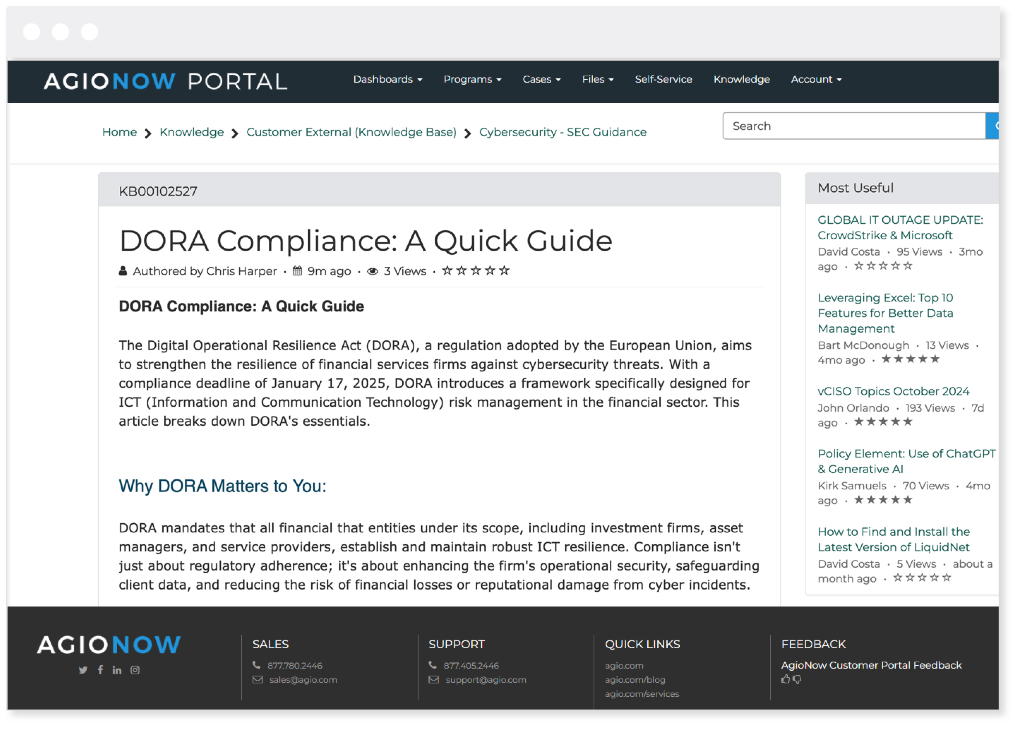A Guide to DORA Compliance: What You Need to Know
The Digital Operational Resilience Act (DORA) represents a major evolution in cybersecurity and operational resilience regulations for financial services within the EU. Its goal is to create a consistent and comprehensive framework that ensures firms can withstand, respond to, and recover from all types of ICT-related disruptions and cyber threats. If your organization has branches in the EU, provides services to EU organizations, or supplies ICT services to EU financial institutions, DORA impacts you.
Let’s break down what this means for your firm and how to stay ahead of the requirements.
Key Pillars of DORA & Their Impact
The biggest overall challenge to firms lies in the scope and scale of DORA’s requirements. Compliance with DORA demands technology upgrades and cultural and operational shifts across the organization. In particular:
- Resource Allocation: Many financial entities, especially smaller firms, may need more internal resources or expertise to meet DORA’s requirements, necessitating significant investments in technology, personnel, and consulting services.
- Complexity of Requirements: The level of detail and comprehensiveness required by DORA, particularly around resilience testing, third-party risk management, and incident reporting, is high and could overwhelm smaller firms or those with a lack of cybersecurity maturity.
- Interdependence with other EU regulations: Compliance with DORA is intertwined with GDPR, NIS Directive, and MiFID II, creating a layered regulatory landscape. Firms must align their compliance efforts across these overlapping frameworks, further complicating implementation.
To successfully implement DORA compliance, you need to focus on three essential areas that work together to create a robust digital resilience framework.
1. Governance & ICT Risk Management
DORA requires that information and communication technology (ICT) risk management is integrated into overall governance frameworks. Your firm must implement a comprehensive risk management system that identifies, protects, detects, responds to, and recovers from ICT-related risks.
Leadership teams must actively oversee digital risks and establish a clear framework that everyone understands, including keeping systems current, documenting processes, and regularly checking that those workflows are operating as intended.
Biggest Lift: Developing standardized ICT risk management frameworks requires a level of detail and integration that many firms haven’t previously maintained. Your firm must implement automated compliance tracking and risk reporting tools that provide real-time visibility into your risk landscape while building ICT risk awareness and oversight at the board level. The organizational shift is substantial—board members and senior management must be trained and held accountable, often requiring firms to establish or strengthen roles such as Chief Information Security Officer (CISO) or Head of Operational Resilience. These systems and roles work together to streamline documentation requirements, track policy updates, and generate the reports your leadership team needs for effective oversight.
2. Resilience Testing & Incident Management
DORA mandates comprehensive incident management and testing requirements, including Threat-Led Penetration Testing (TLPT) for larger institutions and standardized protocols for reporting significant ICT incidents. It goes beyond standard cybersecurity assessments—you’ll need systems that can spot problems quickly and transparent procedures for addressing and reporting incidents. Consider it your digital emergency response plan, complete with processes for notifying authorities and customers when serious incidents occur.
DORA also emphasizes collective defense, encouraging information-sharing among financial entities to create a more robust network against cyber threats. You need systems that can manage and report your incidents effectively and participate in broader industry intelligence sharing.
Biggest Lift: Implementing DORA’s testing and incident management requirements represents a significant investment in resources and expertise. Firms must deploy security information and event management (SIEM) systems, establish 24/7 monitoring capabilities, and create automated alert systems—all while ensuring they have qualified personnel or trusted third-party providers to conduct resource-intensive TLPT and continuous resilience testing. Beyond the technical implementations, you face the challenge of establishing robust incident identification and reporting protocols that align with broader EU mandates, often requiring new processes and careful consideration of confidentiality and data protection concerns when participating in information-sharing networks.
3. Third-Party Risk Management
DORA sets strict guidelines for managing ICT third-party risk, particularly for firms using critical service providers (CSPs). Your firm must assess and manage the risk posed by their technology vendors through rigorous due diligence, contractual requirements, and ongoing monitoring—this means keeping detailed records, conducting thorough checks before signing contracts, and always having a backup plan. A strategic partnership with a trusted provider who understands your business is essential to maintaining resilience.
Biggest Lift: Developing comprehensive third-party risk management programs that align with DORA’s standards requires significant infrastructure and process changes. Firms must implement dedicated platforms for tracking vendor assessments, monitoring performance, and maintaining due diligence documentation while establishing updated exit strategies and monitoring concentration risk. If you’re dependent on external providers for critical infrastructure—especially those using cloud services or other key outsourced IT services—this could mean renegotiating contracts, demanding enhanced transparency and security assurances from vendors, and fundamentally changing their monitoring practices to meet DORA’s specific requirements.
Key Deadlines & Penalties
Meeting DORA requirements means staying on top of critical deadlines. The technical standards under DORA go into effect January 17, 2024; penetration testing must happen every three years, and business continuity plans need annual testing. Most importantly, major incidents require immediate reporting.
Non-compliance with DORA carries severe financial consequences. Individual violations can result in fines up to €1,000,000, while third-party ICT violations may incur penalties up to €5,000,000. For firms, fines can reach 2% of total annual global revenue. In extreme cases, regulators may even suspend company operations.
Beyond the financial and legal penalties, non-compliance puts your entire business at risk. You face potential business disruptions, reputational damage, and eroded customer trust. Proper implementation does more than avoid penalties—it strengthens your operations, improves risk management, and builds stakeholder confidence, which ultimately leads to long-term growth and scale.
Looking Ahead
DORA compliance is more than another regulatory box to check. It’s an opportunity to build a stronger foundation for your firm’s digital future. By taking a balanced approach to technology, risk management, and governance, you’ll be better positioned to handle whatever challenges come your way. Remember that success requires more than good technology—it demands a comprehensive approach to resilience that starts with leadership and extends throughout your firm.
It’s worth noting that if you’re currently a cybersecurity governance program client of ours, upcoming regulatory requirements like DORA will not require significant operational changes. Our governance programs are designed from industry best practices that consistently map to regulatory standards. The foundational elements of DORA —comprehensive risk management, documented incident response procedures, robust testing protocols—are baked into our cyber governance framework as essentials, and our vCISOs directly manage implementing the remaining regulatory complexity DORA requires.
As new regulations like DORA evolve, we’re also consistently updating our Knowledge Center within the AgioNow Portal to keep you informed and compliant, ensuring your organization stays ahead of emerging requirements.

If you’d like to learn more or have a deeper conversation around DORA, connect with us as the first step towards protecting your organization’s digital future.
Share post
Featured Posts
Connect with us.
Need a solution? Want to partner with us? Please complete the fields below to connect with a member of our team.




